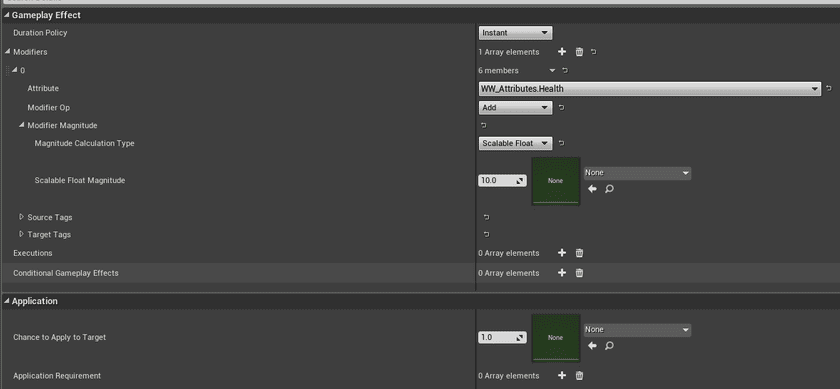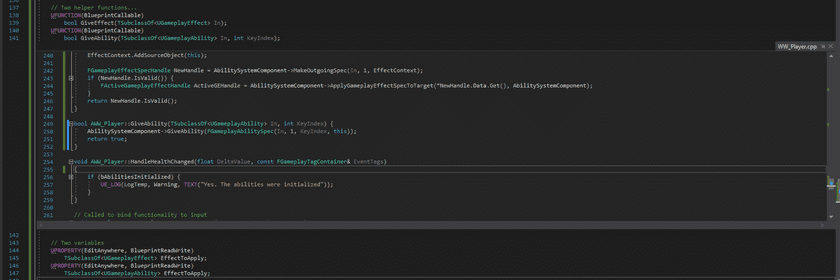Gameplay Ability System (Part 1/3)
About
Okay, when I started with Gameplay Ability System, it was way too huge and seemed totally unnecessary. There is a super high chance that one would never need most of those features. + However, since a full blown framework to design data driven gameplay already exists, I will save myself(and my visitors) some trouble.
Gameplay Effect System
Components and Map
First thing first, There are too many classes involved.
Let's first make a dependency graph so that progress down the linear follows our pattern.
Glimpsed well ? Let's tackle the classes one at a time. (I love graphs. Hope you do, too.)
Step 0. GameplayAttributeData
This class declares parameters. The signature can be summed up to
Currentandbasevalue pair.- #C++ only Getters# and #overrideable setters#, totalling 4 relevant functions.
- Two self explanatory constructors
- GameplayAttributeData() defaulting to zero for the value pair.
- GameplayAttributeData(float val)
What the signature of the
Step 1. Create an AttributeSet
Since this class has #no cross dependencies#, we start with this. It was very difficulty to comprehend at first. The trick is in the macro definition and let me #do the homework for C++ devs# who just want to get up and ready .
// Uses macros from AttributeSet.h
#define ATTRIBUTE_ACCESSORS(ClassName, PropertyName) \
GAMEPLAYATTRIBUTE_PROPERTY_GETTER(ClassName, PropertyName) \
GAMEPLAYATTRIBUTE_VALUE_GETTER(PropertyName) \
GAMEPLAYATTRIBUTE_VALUE_SETTER(PropertyName) \
GAMEPLAYATTRIBUTE_VALUE_INITTER(PropertyName)Will expand to following functions
static FGameplayAttribute Get##PropertyName##Attribute() {
static UProperty* Prop = FindFieldChecked<UProperty>(ClassName::StaticClass(),GET_MEMBER_NAME_CHECKED(ClassName, PropertyName));
return Prop;
}
FORCEINLINE float Get##PropertyName() const {
return PropertyName.GetCurrentValue();
}
FORCEINLINE void Set##PropertyName(float NewVal) {
UAbilitySystemComponent* AbilityComp = GetOwningAbilitySystemComponent(); \
if (ensure(AbilityComp)) {
AbilityComp->SetNumericAttributeBase(Get##PropertyName##Attribute(), NewVal); \
};
}
FORCEINLINE void Init##PropertyName(float NewVal) {
PropertyName.SetBaseValue(NewVal);
PropertyName.SetCurrentValue(NewVal);
}All we need to know from these functions is that, for every
/** Current Health, when 0 we expect owner to die. Capped by MaxHealth */
UPROPERTY(BlueprintReadOnly, Category = "Health", ReplicatedUsing = OnRep_Health)
FGameplayAttributeData Health;
ATTRIBUTE_ACCESSORS(UWW_Attributes, Health)We get the following functions added automatically
| Function | What it does | Important to note |
|---|---|---|
| FGameplayAttribute GetHealthAttribute(); | Gets value of attribute. | Used in attribute evaluation as in pre-processing and post-processing data. |
| float GetHealth(); | Gets current health. | N/A |
| void SetHealth(float NewVal); | Sets base attribute | N/A |
| void InitHealth(float NewVal); | Used to initialize. | It sets both Base and Current value. |
What is GET_MEMBER_NAME_CHECKED
Returns the FName. Its part of assertion macro (error checking).
Below, there are two functions that get fired when we rquest a change in out AttributeSet. Using these we can precondition our data and make any required changes using the new data.
virtual void PreAttributeChange(const FGameplayAttribute& Attribute, float& NewValue) override;
virtual void PostGameplayEffectExecute(const FGameplayEffectModCallbackData& Data) override;- PreattributeChange: used in ARPG to rescale the health and stamina bars.
- PostGameplayEffectExecute: used to handle post-update changes. Any persistent UObject can hold onto a reference to this. Best place to put them would be GIS, GM, PlayerController etc.
Step 2: FGameplayModifierEvaluatedData
The next thing we #should# deal with is the data we can get from FGameplayEffectModCallbackData in #PostGameplayEffectExecute# since that's where effects are applied.
WARNING: - This segment is not needed to get a basic AttributeSet running. +
- This is for advanced use cases. If you are new, please skip to next sectionSignature of FGameplayModifierEvaluatedData has
const struct FGameplayEffectSpec& EffectSpec; // The spec that the mod came from
struct FGameplayModifierEvaluatedData& EvaluatedData; // The 'flat'/computed data to be applied to the target
class UAbilitySystemComponent &Target; // Target we intend to apply to
TIP TLDR: A source, a destination and a payload.
We are more interested in FGameplayModifierEvaluatedData obtained by #FGameplayModifierEvaluatedData.EvaluatedData#
Signature is
FGameplayAttribute Attribute; // Attribute from target UAttributeSet that was changed
TEnumAsByte<EGameplayModOp::Type> ModifierOp; // Added? / multiplied?
float Magnitude; // Delta before clamp
FActiveGameplayEffectHandle Handle; // Handle to GE. Invalid in most cases as mentioned by epic
bool IsValid; // safety checks
FString ToSimpleString() const // Will give FName, ModifiedOp mode, Delta in that orderBeyond this, for simplest single player games, we do #minor tweaking# and #pass data# onto whoever handles the methods we created in that Step 1 complex macro. + #Take the code lightly#, if you are starting out. try casting to your custom Actor, Controller, Character and running test scripts in their body. The next section will clear up what needs to be done on your #character side#.
Step 3. Adding an attribute
On player side, we have to implement the IAbilitySystemInterface . For now lets assume a single attribute, health.
We add the folowing lines to
// This has to be implemented in BP
UFUNCTION(BlueprintImplementableEvent)
void OnHealthChanged(float DeltaValue, const struct FGameplayTagContainer& EventTags);
// Called from RPGAttributeSet, these call BP events above
virtual void HandleHealthChanged(float DeltaValue, const struct FGameplayTagContainer& EventTags);
// Friended to allow access to handle functions above
friend URPGAttributeSet;So we are keeping the blueprint macros for later. For now, this is what it would look like in pure C++.
// Called from OurAttributeSet, these are handled by us natively in C++
virtual void HandleDamage(float DamageAmount, const FHitResult& HitInfo, const structFGameplayTagContainer& DamageTags, ARPGCharacterBase* InstigatorCharacter, AActor*DamageCauser);
virtual void HandleHealthChanged(float DeltaValue, const struct FGameplayTagContainer&EventTags);
virtual void HandleManaChanged(float DeltaValue, const struct FGameplayTagContainer&EventTags);
virtual void HandleMoveSpeedChanged(float DeltaValue, const structFGameplayTagContainer& EventTags);
// Friended to allow access to handle functions above
friend URPGAttributeSet;For your future reference, this snippet routed the logic in ARPG
// Native C++ class
void ARPGCharacterBase::HandleHealthChanged(float DeltaValue, const struct FGameplayTagContainer& EventTags)
{
// We only call the BP callback if this is not the initial ability setup
if (bAbilitiesInitialized)
{
// Blueprint event
OnHealthChanged(DeltaValue, EventTags);
}
}I had a very hard time getting FGameplaySpecHandle and few other structs in BP, so I would definitely recommend handling GAS logic in C++.
Next, I would like you to add a public variable and a function. These will be used to assign effects directly from BP.
The public variable
In the code below, there are 3 examples of how we could define a single/list of effects.
// Basic demo for a single ability (Using class reference)
TSubclassOf<UGameplayEffect> OneEffect;
// Extra info : Instanced classes would be passed like this.
TArray<UGameplayEffect*> OneEffect;
// Later on tutorial, we will use arrays like these to insert multiple class references
TArray<TSubclassOf<UGameplayEffect>> EffectArray;The function
This will grant the effect to our pawn. Fow now we want to do handle all logic in C++.
void GiveAbility(TSubclassOf<UGameplayAbility> In) {
FGameplayEffectContextHandle EffectContext = AbilitySystemComponent->MakeEffectContext();
EffectContext.AddSourceObject(this);
// We set the level to 1 here for simplicity
FGameplayEffectSpecHandle NewHandle = AbilitySystemComponent->MakeOutgoingSpec(In, 1, EffectContext);
if (NewHandle.IsValid()) {
FActiveGameplayEffectHandle ActiveGEHandle = AbilitySystemComponent->ApplyGameplayEffectSpecToTarget(*NewHandle.Data.Get(), AbilitySystemComponent);
}
}Great, we are done here. Time to boot up the editor and add an effect. We derive from the normal GameplayEffect class. Try to brew a potion like this

These are the fields we have learnt so far. Add 10 HP flat to Health attribute of WW_Attributes(My UAttributeSet derived class) +
And next create a triggerbox/sphere BP and have it do this. #GiveAbility# was the function name I chose.

I hope everything should work up until noe.
But, if you recall, we hard coded the level and input etc. That's why we have the GameplayEffect blueprints.
It gives us the flexibility and scaling system using curves. More on that later. +
We have a working GameplayEffect system and its time to build a working GameplayAbility system.
Gameplay Ability System
There is broad use cases of the ability System. At a basic level it can make your ability buttons do different things. This means we can select froma pool of skills and make available depending on selected character. Also, it seems the way to do this is surprisingly simple.
Create a class derived from UGameplayAbility. we will understand the dash ability that comes with the plug-in as sample.

The full list of functions can be seen in the UGameplayAbility class. The ones that you might want to look-out for are :-
- InputPressed: Called when the key is pressed (Given that the ability is granted to the player)
- InputReleased: Called when the key is released (Given that the ability is granted to the player)
ActivateAbility will firstly commit the ability (meaning spend the resources) and then depending on if the commit was successful, do the next listed commands. We can stack our gameplay logic here like this.

TIP: I know that I am skipping a lot of network stuff. But, it is #outside my scope# and the #authority checks will always return true# for a single player game. Just #letting the functions stay# so that people coming from ARPG #won't get confused#.
Next, #add another BP exposed variable# of type TSubclassOf<UGameplayAbility> to the player class. +
Now you can activate those abilities like this.
This will make the player jump only if you granted him the ability.
void GiveAbility(TSubclassOf<UGameplayAbility> In, int KeyIndex) {
/* This function is one of the ways to give ability. Params are
* @1 : The class reference
* @2 : Level. Lets set it to one for simplicity
* @3 : Key binding. set it to zero. Well discuss this later
* @4 : One of the extra constructor param. Will be covered later.
*/
AbilitySystemComponent->GiveAbility(FGameplayAbilitySpec(In, 1, KeyIndex, this));
}Checkpoint
Please check that you got the following stuff running without errors
(Heres the code upto now...)
A player class that has/does (Refer following images)
- Implements the IAbilitySystemInterface.
- Has an instance deriving from UAbilitySystemComponent.
- Has an instance deriving from UAttributeSet. (This should have only health fields for now.)
- Has two variables and two functions that look like the following.


Great. And as you can see, we can apply effects and arrays like the following.
Thank you for visiting!
Hope you got the resources you needed. Come visit again :)
I upload weekly and revamp bi-monthly. You can support my work at Patreon | Paypal | Marketplace | Gumroad

